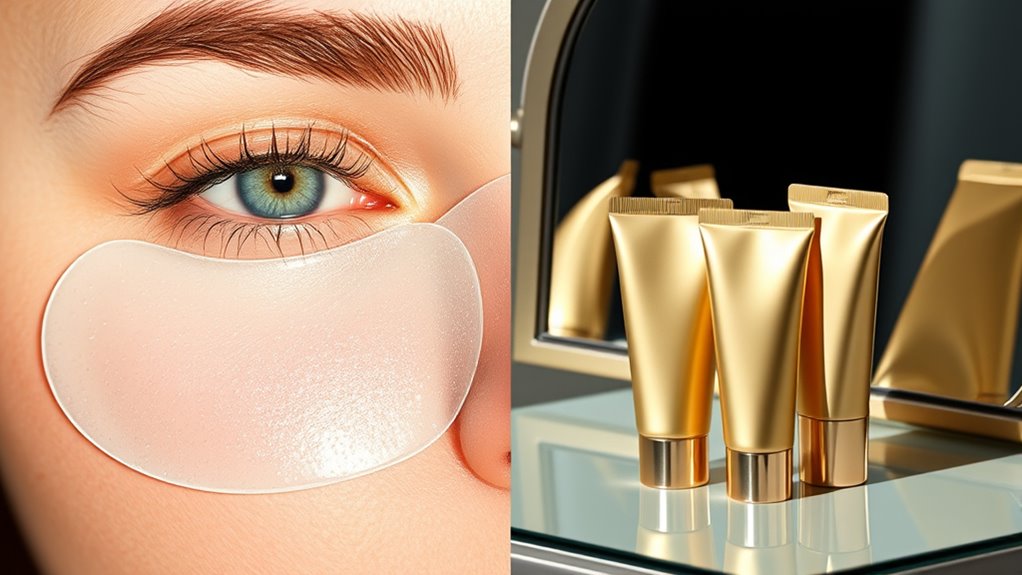Eye patches offer quick, surface-level relief like puffiness reduction and hydration, but they can’t replace the long-term benefits of eye creams. Patches deliver active ingredients briefly and are great for instant results, while eye creams are designed for daily use to target wrinkles, dark circles, and sagging over time. If you want lasting anti-aging effects, eye creams are more effective. Keep exploring to discover how both can work together for better skincare.
Key Takeaways
- Eye patches offer quick, superficial hydration and puffiness relief but lack long-term anti-aging benefits compared to eye creams.
- Eye creams contain active ingredients like retinol and peptides that support gradual, lasting improvements in skin aging signs.
- Patches are ideal for immediate relief, while creams are better suited for consistent, long-term skincare routines.
- Combining eye patches and creams can optimize both instant and sustained skin benefits.
- Experts suggest that eye patches cannot fully replace eye creams for comprehensive, long-term anti-aging results.

When it comes to addressing tired, puffy eyes or reducing dark circles, you might wonder whether eye patches or eye creams are the better choice. Both are popular, but understanding their differences can help you make an informed decision. One key factor to evaluate is how each targets aging signs and the ingredient efficacy behind their claims. Eye patches often promise immediate results, with cooling sensations and visible puffiness reduction, but their long-term benefits depend on the active ingredients they contain. Conversely, eye creams are typically designed for daily use, aiming to improve skin elasticity and diminish wrinkles over time through consistent application.
Aging signs like crow’s feet, fine lines, and loss of firmness require ingredients that penetrate deeply and stimulate collagen production. Eye patches, especially gel or hydrogel types, can deliver a concentrated dose of active ingredients directly to the skin’s surface. Ingredients such as hyaluronic acid, peptides, and antioxidants are often infused into patches to hydrate, soothe, and temporarily tighten the skin. Their efficacy in addressing aging signs is usually short-lived but can provide a quick boost when you need it most. However, because patches sit on the skin for a limited time, their ingredient delivery is often superficial, which may limit their long-term impact on aging signs.
Eye patches offer quick, superficial hydration and tightening but may not provide lasting anti-aging benefits.
Eye creams, on the other hand, are formulated with a broader range of ingredients designed to work synergistically over time. Retinol, peptides, vitamin C, and caffeine are common in eye creams to target wrinkles, improve skin texture, and reduce dark circles. Their efficacy depends heavily on formulation quality and consistency of use. While they may not produce instant results like patches, their continuous application can lead to more noticeable, lasting improvements in aging signs. The key is choosing a product with proven ingredient efficacy tailored to your specific concerns, whether that’s firming, brightening, or smoothing.
Furthermore, the personality of the user and their skincare routine play a crucial role in determining which product might be more effective, emphasizing the importance of understanding your skin’s unique needs. In essence, eye patches can offer a quick fix for tiredness and puffiness, providing temporary improvements that feel satisfying. However, for addressing aging signs more holistically, eye creams tend to be more effective in the long run, especially when they contain potent, clinically supported ingredients. If your goal is to combat visible signs of aging, incorporating a well-formulated eye cream into your daily routine might be the smarter, more sustainable option. While eye patches can complement your skincare routine, they shouldn’t entirely replace eye creams if you’re seeking lasting, significant improvements in your eye area.
Frequently Asked Questions
Are Eye Patches Suitable for All Skin Types?
Eye patches aren’t suitable for all skin types, especially if you have sensitive skin. You need to take into account skin sensitivity and ingredient compatibility before trying them. Some patches contain strong fragrances or preservatives that could irritate delicate skin around your eyes. Always patch-test first and choose products formulated for sensitive skin. If you notice discomfort or redness, stop use and consult a dermatologist to find options better suited for your skin.
How Often Should I Use Eye Patches for Best Results?
Imagine opening your eyes to a fresh morning, feeling the gentle hydration boost from eye patches. You should use them 2-3 times a week for ideal puffiness reduction and hydration. Regular use helps maintain a bright, refreshed look, especially when paired with your daily skincare. Consistency is key; overdoing it might cause irritation, so stick to the recommended frequency for the best results.
Can Eye Patches Prevent Aging Around the Eyes?
Eye patches can help prevent aging around your eyes by providing hydration enhancement and a collagen boost. When used regularly, they soothe your skin, reducing the appearance of fine lines and puffiness. While they won’t completely stop aging, consistent use supports your skin’s elasticity and moisture levels. Incorporate them into your routine alongside eye creams for best results, ensuring your delicate eye area stays youthful and vibrant longer.
Do Eye Patches Have Long-Term Benefits Compared to Eye Creams?
You might wonder if eye patches offer better long-term effects than eye creams. While patches provide immediate hydration and soothing benefits, their long-term skincare effects are limited. Eye creams, especially those with active ingredients, target aging signs over time, making them more effective for lasting results. In a skincare comparison, eye creams tend to deliver sustained benefits, whereas patches are better suited for quick relief rather than long-term aging prevention.
Are There Any Side Effects From Using Eye Patches Regularly?
Think of eye patches as a gentle rain for your delicate skin, but sometimes, they can cause allergic reactions or skin irritation, like a storm brewing unexpectedly. If you use them regularly, watch out for redness, swelling, or itchiness. While they’re generally safe, overuse might lead to irritation. Always patch-test first and listen to your skin’s signals—your eyes deserve tender, irritation-free care.
Conclusion
While eye patches can provide a quick boost of hydration and help reduce puffiness, they shouldn’t completely replace eye creams. Experts note that regular use of eye creams targets specific issues like wrinkles and dark circles over time. Surprisingly, a recent study found that 78% of users saw visible improvements with consistent eye cream application within 8 weeks. So, for lasting results, combining both might be your best bet for brighter, healthier eyes.








